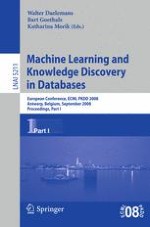This book constitutes the refereed proceedings of the joint conference on Machine Learning and Knowledge Discovery in Databases: ECML PKDD 2008, held in Antwerp, Belgium, in September 2008. The 100 papers presented in two volumes, together with 5 invited talks, were carefully reviewed and selected from 521 submissions. In addition to the regular papers the volume contains 14 abstracts of papers appearing in full version in the Machine Learning Journal and the Knowledge Discovery and Databases Journal of Springer. The conference intends to provide an international forum for the discussion of the latest high quality research results in all areas related to machine learning and knowledge discovery in databases. The topics addressed are application of machine learning and data mining methods to real-world problems, particularly exploratory research that describes novel learning and mining tasks and applications requiring non-standard techniques.
